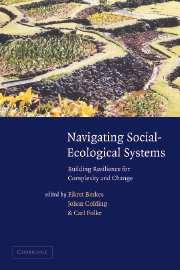Book contents
- Frontmatter
- Contents
- List of contributors
- Preface
- Acknowledgements
- Foreword: The backloop to sustainability
- 1 Introduction
- Part I Perspectives on resilience
- 2 Adaptive dancing: interactions between social resilience and ecological crises
- 3 Nature and society through the lens of resilience: toward a human-in-ecosystem perspective
- 4 Redundancy and diversity: do they influence optimal management?
- Part II Building resilience in local management systems
- Part III Social-ecological learning and adaptation
- Part IV Cross-scale institutional response to change
- Index
- References
2 - Adaptive dancing: interactions between social resilience and ecological crises
Published online by Cambridge University Press: 13 August 2009
- Frontmatter
- Contents
- List of contributors
- Preface
- Acknowledgements
- Foreword: The backloop to sustainability
- 1 Introduction
- Part I Perspectives on resilience
- 2 Adaptive dancing: interactions between social resilience and ecological crises
- 3 Nature and society through the lens of resilience: toward a human-in-ecosystem perspective
- 4 Redundancy and diversity: do they influence optimal management?
- Part II Building resilience in local management systems
- Part III Social-ecological learning and adaptation
- Part IV Cross-scale institutional response to change
- Index
- References
Summary
Introduction
Systems of people and nature co-evolve in an adaptive dance (Walters, 1986). Resource systems change as people seek ecosystem services, such as the harvest of stocks, manipulation of key structuring processes, removal of geophysical assets or abation of pollutant concentrations. Meanwhile, as humans are becoming more dependent on these ecosystem services, the ecosystems become more vulnerable to unexpected events. This process that signals a loss of ecological resilience has been described as a pathology of resource development (Holling, 1995).
Complex resource systems are not easily tractable or understood, much less predictable. Nonlinear interactions among multiple variables, scale invariant processes, emergent properties from self-organization and other factors all contribute to unpredictability. Yet, even with these inherent difficulties, we continue attempts at making sense for management and other purposes. Due to a growing empirical base of observation, emergent patterns of these systems, including periods of stability and instability, as well as unexpected behavior due to internal and external changes have been revealed (Gunderson, Holling, and Light, 1995; Berkes and Folke, 1998; Johnson et al., 1999).
This paper builds on earlier work (Holling, 1978; Walters, 1986, 1997; Gunderson et al., 1995; Gunderson, 1999a) to explore these unexpected behaviors in managed ecological systems – perceived as surprises and crises. To begin with, the conceptual basis for understanding these nonlinearities, ecological properties of resilience and adaptive capacity, and analogous properties in institutions are presented.
- Type
- Chapter
- Information
- Navigating Social-Ecological SystemsBuilding Resilience for Complexity and Change, pp. 33 - 52Publisher: Cambridge University PressPrint publication year: 2002
References
- 18
- Cited by



